A case report of oral contraceptive misuse induced cerebral venous sinus thrombosis and dural arteriovenous fistula
- PMID: 31415348
- PMCID: PMC6831267
- DOI: 10.1097/MD.0000000000016440
A case report of oral contraceptive misuse induced cerebral venous sinus thrombosis and dural arteriovenous fistula
Abstract
Rationale: Consumption of oral contraceptive pills (OCP) is a known risk factor for cerebral venous sinus thrombosis (CVST) among women. Development of dural arteriovenous fistula (dAVF) afterwards was very uncommon. We present a rare chronic complication of development of dAVF after CVST.
Patient concerns: A 22-year-old woman suffered headache for a week. She was then admitted into our hospital.
Diagnosis: Contrast enhanced magnetic resonance venography (MRV) demonstrated the thrombosis of the left transverse-sigmoid sinus the second day.
Interventions: The intravenous thrombolysis was carried out. As the symptoms improved, the patient was discharged, while the treatment with oral dabigatran continued. However, 3 months after the onset, magnetic resonance imaging (MRI) showed swelling brainstem, and digital subtraction angiography (DSA) confirmed a dAVF. Clipping of the fistula was conducted, and her clinical symptoms improved gradually.
Outcomes: The patient was transferred to rehabilitation center later, and received follow-up care.
Lessons: When a patient taking OCP and suffering from a sudden headache, a clinical suspicion of possible CVST should always arise to avoid the onset of dAVF as soon as possible.
Conflict of interest statement
The authors have no conflicts of interests to disclose.
Figures
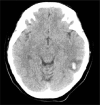
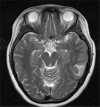
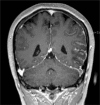
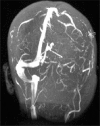
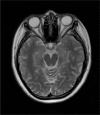
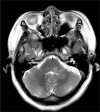
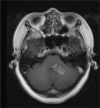
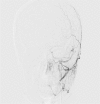
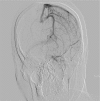
Similar articles
-
Dural Arteriovenous Fistula Complicated with Cerebral Venous Sinus Thrombosis.World Neurosurg. 2020 Feb;134:348-352. doi: 10.1016/j.wneu.2019.10.075. Epub 2019 Oct 19. World Neurosurg. 2020. PMID: 31639507
-
Optic neuropathy, a warning for cerebral venous sinus thrombosis and underlying dural arteriovenous fistulae.J Int Med Res. 2022 Jul;50(7):3000605221078071. doi: 10.1177/03000605221078071. J Int Med Res. 2022. PMID: 35899780 Free PMC article.
-
Cerebral venous sinus thrombosis complicated with acute development of dural arteriovenous fistula: A case report.J Clin Neurosci. 2017 Oct;44:225-226. doi: 10.1016/j.jocn.2017.06.011. Epub 2017 Jun 30. J Clin Neurosci. 2017. PMID: 28673669
-
Ruptured dural arteriovenous fistula and sinus venous thrombosis following surgical resection of a vestibular schwannoma: Case report and review of the literature.Neurochirurgie. 2022 Dec;68(6):688-692. doi: 10.1016/j.neuchi.2022.03.008. Epub 2022 May 20. Neurochirurgie. 2022. PMID: 35599062 Review.
-
Documented development of a dural arteriovenous fistula in an infant subsequent to sinus thrombosis: case report and review of the literature.Neuroradiology. 2010 Mar;52(3):225-9. doi: 10.1007/s00234-009-0608-6. Epub 2009 Oct 13. Neuroradiology. 2010. PMID: 19823815 Review.
Cited by
-
The Gridlock Between Chronic Cerebral Venous Thrombosis and Dural Arteriovenous Fistulas.Cureus. 2023 Feb 15;15(2):e35035. doi: 10.7759/cureus.35035. eCollection 2023 Feb. Cureus. 2023. PMID: 36942193 Free PMC article.
-
Cerebral venous sinus thrombosis and dural arteriovenous fistula associated with protein S deficiency: a case series study.BMC Neurol. 2022 May 2;22(1):164. doi: 10.1186/s12883-022-02693-3. BMC Neurol. 2022. PMID: 35501720 Free PMC article.
-
Efficacy of intravascular mechanical thrombectomy combined with thrombolysis and anticoagulant therapy in the treatment of cerebral venous sinus thrombosis and its effect on neurological function and coagulation indices.Am J Transl Res. 2021 Jun 15;13(6):6921-6928. eCollection 2021. Am J Transl Res. 2021. PMID: 34306444 Free PMC article.
-
Unforeseen uses of oral contraceptive pills: Exploratory study in Jordanian community pharmacies.PLoS One. 2020 Dec 21;15(12):e0244373. doi: 10.1371/journal.pone.0244373. eCollection 2020. PLoS One. 2020. PMID: 33347511 Free PMC article.
-
Cyclosporine-A-Induced Intracranial Thrombotic Complications: Systematic Review and Cases Report.Front Neurol. 2021 Feb 11;11:563037. doi: 10.3389/fneur.2020.563037. eCollection 2020. Front Neurol. 2021. PMID: 33643175 Free PMC article.
References
-
- Chen JG, Li ZX, Zhang DF, et al. Cerebral venous sinus thrombosis complicated with acute development of dural arteriovenous fistula: a case report. J Clin Neurosci 2017;44:225–6. - PubMed
-
- Das JK, Medhi J, Bhattacharya P, et al. Clinical spectrum of spontaneous carotid-cavernous fistula. Indian J Ophthalmol 2007;55:310–2. - PubMed
-
- Siddiqui FM, Kamal AK. Incidence and epidemiology of cerebral venous thrombosis. J Pak Med Assoc 2006;56:485–7. - PubMed
-
- Azin H, Ashjazadeh N. Cerebral venous sinus thrombosis–clinical features, predisposing and prognostic factors. Acta Neurol Taiwan 2008;17:82–7. - PubMed
Publication types
MeSH terms
Substances
LinkOut - more resources
Full Text Sources
Research Materials

